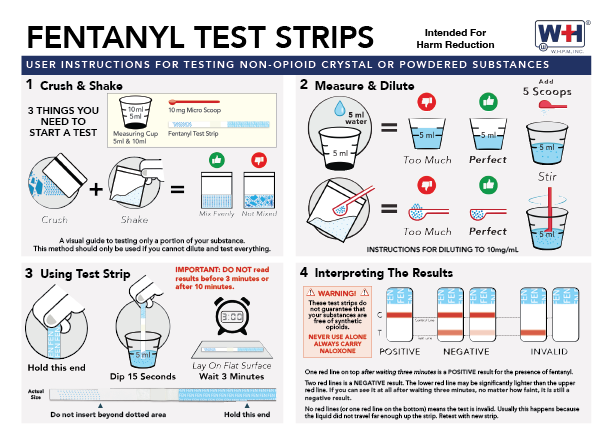Fentanyl Test Strips
A harm reduction intervention to help reduce overdoses.
What Is Fentanyl?
Fentanyl is a powerful synthetic opioid fifty times stronger than heroin. Since about 2018 it has become the dominant opioid on the illicit market. Found in pills and powders, including non-opioid drugs and counterfeit pharmaceuticals, fentanyl is responsible for tens of thousands of deaths a year in the U.S. alone.
National Opioid Overdose Deaths (primarily fentanyl)
Source: https://nida.nih.gov/research-topics/trends-statistics/overdose-death-rates
About The WHPM Fentanyl Test Strips
The WHPM fentanyl test strips were developed specifically for harm reduction use. With a detection cutoff of 10 ng/ml, they are one of the most sensitive test strips on the market. They are also highly selective to fentanyl and its analogs, meaning they are less likely to cross-react with other, non-fentanyl-related drugs.
The Importance of Sample Preparation
When fentanyl is contaminating other substances, it is unlikely to be mixed evenly. This is called the “chocolate chip cookie effect” and is why the best recommendation is to dilute and test the entire sample of the substance (i.e. pill or baggie of powder). However, because many people are only willing or able to test a small portion of their substance, sample preparation to avoid false negatives and false positives is extremely important. Here are the three components of proper sample preparation:
1. Crush and mix - In order to reduce the chocolate chip cookie effect and redistribute any fentanyl as evenly as possible throughout the sample, the entire sample must be crushed and mixed thoroughly.
2. Test as much as you are willing - To maximize the chance that the portion being tested will contain fentanyl (if fentanyl is contaminating the sample), test the largest amount possible. WHPM recommends a minimum of 50 mg.
3. Dilute the portion to 10 mg/ml* - To maximize the chance of detecting even a tiny amount of fentanyl that was hopefully captured in the chosen portion, dilute the portion only enough to avoid false positives, and not much more.** The WHPM fentanyl test strips have been laboratory tested on the most common drugs and drug cuts, and they did not produce false positives even at the high concentration of 10 mg/ml in water.***
Following the protocols for sample preparation above are the best practices for using the WHPM Fentanyl Test Strip. Instructions from other suppliers offering non-specific dilution protocols (i.e., “put a little bit of powder into a small amount of water") risk false positives and false negatives.
The following User Instructions were specifically developed to optimize the performance of the WHPM Fentanyl Strips to ensure accurate detection while limiting the possibility of cross-reactivity.
* The 10 mg/ml dilution is specific to WHPM Fentanyl Test Strips. Fentanyl Test Strips for harm reduction use from other manufacturers require independent laboratory assessment to determine their sensitivity and specificity performance characteristics.
** At higher concentrations, many substances can produce a false positive result. This is why Harm Reduction Use specific laboratory assessment must be conducted to determine the sensitivity and specificity performance characteristics of a test strip.
*** Diphenhydramine gives false positives with all fentanyl test strips on the market. Fortunately, diphenhydramine is not typically found in illicit, non-opiod drug samples.




